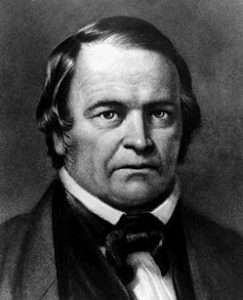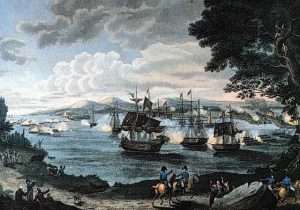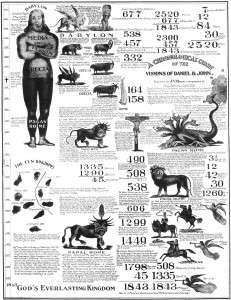William Miller famously led thousands of people on a religious wild goose chase in 1844 that ended only when (to his followers’ disappointment) the world did not end. If Miller proved nothing else in his lifetime of religious scholarship, he proved this: False faith is a powerful intoxicant.
 Miller was born in 1782 in Pittsfield, Mass. His father, a farmer, at first discouraged his son’s scholarly interests. Young William Miller, however, persisted in reading everything he could lay his hands on, though he had little formal education.
Miller was born in 1782 in Pittsfield, Mass. His father, a farmer, at first discouraged his son’s scholarly interests. Young William Miller, however, persisted in reading everything he could lay his hands on, though he had little formal education.
At 21, he married Lucy Smith, a well-connected young woman, and moved to her home town in Poultney, Vt. With her father’s help, he won positions as constable and deputy sheriff. He might well have expected to rise to the office of high sheriff, but with the War of 1812 looming he opted to join the military in 1810. Though he could have avoided military service, Miller, perhaps inspired by his father’s service in the Revolutionary War, enlisted in the Vermont militia. Later he transferred to the regular Army.
Much of his work involved recruiting, though he fought in the 1814 Battle of Plattsburgh, the capstone of the War of 1812.
William Miller, Deist
He returned from the war a changed person. He suffered a head injury when he fell out of a wagon early in his military service, which may have altered his personality. But whatever the reason, he had moved away from his initial Baptist faith and began toying with Deism. This period of his life ended with a vengeance when he became obsessed with the Bible.
In 1814, William Miller moved across the border to Low Hampton, N.Y., where his mother and brother lived. There, he and Lucy set up a farm. Perhaps in response to jokes about his religious about-face, Miller grew determined to master the Bible. He spent endless hours reading and researching it. He became obsessed with knowing when and how Christ would return, and he believed the Bible held the answers if he could only decode its date references.
By 1822, William Miller thought he had his answer: The end was near. He kept the information close, however, and continued a relatively quiet life as a lay minister and farmer. All the while, however, he refined his thinking, questioning his obsession and examining his dreams for insights.
In 1832, he had taken to the pulpit as a preacher. He also submitted articles to the Vermont Telegraph, a Baptist newspaper, explaining his views. He received an immediate and overwhelming response. Letters poured in asking for greater detail and for a defense of his views. And so Millerism was born.
Millerism
Miller lectured in and around Vermont and New York. As his message spread, the invitations came from farther away in Massachusetts, New Hampshire, Maine and Connecticut.
By 1840, the momentum behind Millerism was unstoppable. A Boston publisher, Joshua Vaughn Himes, began publishing a newspaper dedicated to Miller’s teachings, and the lecture tour continued.
All was not smooth sailing, however. Local ministers often challenged William Miller. Sometimes his speeches didn’t go over well. At a Newburyport, Mass., event, someone in the audience threw an egg at him while on stage and later threw rocks through the windows.
Attacks on the Millerites, however, only drew them closer together in their beliefs. And they began pressing Miller for greater specificity about when, precisely, Christ would be returning. By 1843 they thought they had their answer: 1844. After some false starts, eventually the believers narrowed that date to October 22, 1844.
By then, Millerites numbered between 50,000 and 100,000, spread across the United States and into Canada. New England and New York contained the greatest concentrations, with most living in eastern and central Massachusetts.
The Great Disappointment
Stories of the event abound. Some members of the church neglected their farms and other affairs and sold their possessions, expecting to be drawn upward to heaven.
Women who lived in or near Worcester, Mass., cut off their hair, gave away their jewelry and took the ruffles off their dresses. Many Millerites made long white gowns for themselves — ‘ascension robes’ for the big day.
Many who lived in Groton, Mass., climbed Mt. Wachusett to await the Second Coming. One old man from Harvard, Mass., couldn’t make it up the mountain but he perched at the top of his tallest apple tree. A white-robed family in New Bedford also chose an apple tree to await the Lord’s arrival.

View of Camden, Maine, from Camden Hills State Park.
In Maine, stories abounded about Millerites climbing to rooftops so they could be more easily lifted to the sky. In Camden Hills State Park, hikers still visit the Millerite Ledges, where Millerites went on October 22, 1844, to await ascension.
By October 23, of course, the story was over. Linus had awakened with no visit from the Great Pumpkin. And the Millerites suffered what they would later term, ‘the Great Disappointment.’
William Miller wrote of the ridicule his followers endured:
Some are tauntingly enquiring, ‘Have you not gone up?’ Even little children in the streets are shouting continually to passersby, ‘Have you a ticket to go up?’
Aftermath
After the disappointment, William Miller himself continued to lecture, though his popularity waned. Segments of his following sought other faiths, including the Shakers and the Quakers. He laid no claim to churches that were once Millerite, but had been scavenged and occupied by other faiths.
Others built on his work, creating out of it the Advent Christian Church, which flourishes still. William Miller himself went home. Though frequently the butt of jokes, he believed until his death in 1849 that the end was near.
This story about William Miller last updated in 2023.
Image: Camden Hills State Park By Dudesleeper at English Wikipedia, CC BY-SA 3.0, https://commons.wikimedia.org/w/index.php?curid=6380561




2 comments
[…] was hardly the only religious leader to predict the end of the world, which many tied to the coming coming new century. He and his followers practiced various scenarios […]
[…] Not all apocalyptic movements are violent, of course. The Millerites, disciples of William Miller, believed that, via the study of the book of Daniel, they had discovered the key to when Jesus would return to Earth. Coming out the Second Great Awakening, the Millerite movement was one of a number of groups refocusing their attention on the impending apocalypse. In the 1830s Miller started preaching his belief that Jesus would soon return, not only holding camp meetings—which, by the early 1840s, had attracted approximately a million total attendees (though only a fraction believed Miller)—but also by harnessing the high-speed printing presses of the day to churn out pamphlets, newsletters, newspapers, and colored charts explaining Miller’s system. These, alongside charismatic aides, helped turn the movement into a mass phenomenon. The core believers may have numbered somewhere in the 50-100,000 range, primarily in New England and New York but with adherents across t…. […]
Comments are closed.